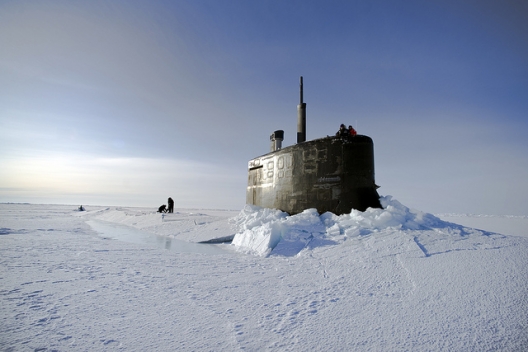Arctic Passage Opens Challenges for US Military

The 40-year-old Coast Guard icebreaker Polar Star returned to the Arctic Ocean this summer after seven years in semiretirement, charging into a thinning polar ice sheet that U.S. defense officials predict will give way to new commercial waterways and a resource-rich frontier by midcentury.
Navy officials say the Arctic will give the U.S. its first new ocean to police since the annexation of the Pacific Northwest in 1846. As the ice surrounding the North Pole retreats, officials say, commercial shippers will be able to eventually move goods faster between Asia and Europe. More open seas will also give energy companies greater access to offshore oil and gas in regions controlled by the U.S. and estimated by military officials to be worth $1 trillion.
"The inevitable opening of the Arctic will essentially create a new coast on America's north," said Adm. Jonathan Greenert, the Navy's top officer.
Even though the anticipated change is years away, Navy and Coast Guard officials say the U.S. needs to prepare now to patrol and defend the new waterways—designing ice-resistant ships and expanding Arctic naval exercises—when military scientists predict a new expanse of water freed of ice.
A new Navy strategy, set for release in coming weeks, says increased commercial traffic, oil and gas exploration and tourism will create new demands in the Arctic. The paper, a draft of which was reviewed by The Wall Street Journal, notes the Navy lacks "operational experience" and ships properly outfitted for the extreme weather. It must also address poor satellite coverage.
Pentagon budget cuts, however, make plans for the new Arctic frontier difficult. "This is not a good time to be putting a lot of bills on the table," said Army Gen. Charles Jacoby, the top officer at Northern Command, the military headquarters that oversees the Arctic Ocean.
While the Pentagon budget remains large, military spending is falling faster than any time since the end of the Korean War. The Pentagon faces $31 billion in spending cuts this year and $42 billion next year.
In November, Defense Secretary Chuck Hagel said the department must prepare to exercise U.S. sovereignty in the Arctic, despite budget cuts, and extend protection of the seas there.
For now, the defense of Arctic waters belongs to the Polar Star, the Coast Guard's single heavy icebreaker, and the service's medium icebreaker, the Healy. . . .
With little money for new ships, the Polar Star is assigned double duty: working the Arctic in the summer and the Antarctic in winter. . . .
Some military officials would like to see 10% or more of new Navy ships ice-hardened for the expected expansion of Arctic operations. Now, it has none. Hardening a Navy warship for Arctic seas could cost as much as $300 million, officials said.
Russia, by contrast, has 25 icebreakers, including six that are nuclear powered, according to the Center for Strategic and International Studies, a nonpartisan Washington think tank. Russian President Vladimir Putin recently promised to reopen old Arctic bases, a sign of Moscow's investment in the far north.
Some in the Navy and Coast Guard contend the U.S. will need as many as 10 icebreakers—at an estimated cost of $784 million per ship—to keep shipping lanes free of ice, as well as aid search and rescue missions and ensure safe travel for vessels. . . .
Coast Guard officials say traffic in the Arctic Ocean is expanding. The service tracked 240 ships operating off northern Alaska last year, compared with 190 in 2011. A ship from China last year used an Arctic sea route above Russia to shave two weeks off the time needed to reach Europe.
"Maritime commerce is happening at a much faster rate than people realize," said Rear Adm. Thomas Ostebo, who commands the Coast Guard's Alaska district. "All this activity gives opportunity for calamity."
HEADLINES
- Do shipping markets want Biden or Trump for the win?
- All 18 crew safe after fire on Japanese-owned tanker off Singapore
- Singapore launching $44m co-investment initiative for maritime tech start-ups
- Cosco debuts Global Shipping Industry Chain Cooperation Initiative
- US warns of more shipping sanctions
- China continues seaport consolidation as Dalian offer goes unconditional